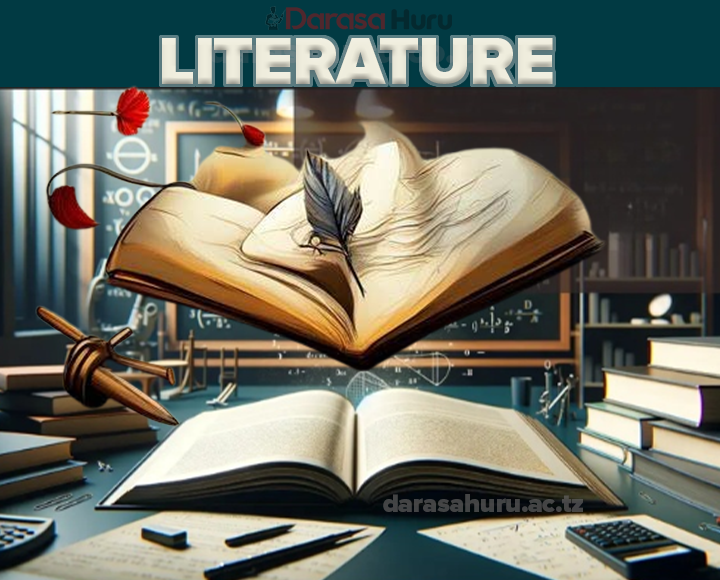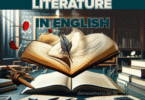STUDY QUESTIONS ON LITERATURE IN ENGLISH
STUDY QUESTIONS
QUESTIONS ON ENGLISH IN LITERATURE: Through question, an attempt is made to ascertain and evaluate the knowledge of students in regard to the subject. This method ensures participation.
THEORIES OF LITERATURE
1. (a) Write a literary term that corresponds to each of the following descriptions.
(i) The freedom to violate grammatical rules in poem is called……….
(ii).……..is the process of giving roles to subjects who are involved in a literary work.
(iii) The involvement of two or more characters is speaking upon an idea is termed as…….
(iv).……… is the speaker or a dramatist in the poem
(v).……….do indicate that the play is over
(b) What does the following literary terms mean in literature?
(i) Technique
(ii) Mood
(iii) Symbolism
(iv) Proverbs
(v) Comedy
2. By giving the title of a song, proverb or an idiom; use five points to reveal on the notion that, “literature is still advantageous among Tanzanians today” (Give your examples in Swahili language)
3. a) Define the following terms as used in literature.
i) Comedy drama
ii) Suspense
iii) Dialogue
iv) Diction
v) Poetic license
vi) Flashback
vii) Riddle
viii) Allusion
b) Contrast the following pairs of literary terminologies.
i) Tone and Mood
ii) Archaism and Euphemism
iii) Tragedy and Tragic-comedy
iv) Proverb and Idiom
v). Antagonist and Protagonist
vi) Hyperbole and Litotes
4. To each of the following descriptions write COR as the statement is TRUE and INC to FALSE statements.
(i) Conflicts happening in any novel are very important in the development of plot.
(ii) Metonymy is the process of giving roles to subjects involved in a literary work.
(iii) Setting can indicate both the status and the subject matter of a play read.
(iv) “As without water no life” also “without language there is no literature”.
(v) The device which use words in creating mental picture is called symbolism.
5. Argue against the notion that, “The study of Oral Literature has no use in the modern society of today” (Give at least five points)
6. By giving one example, explain on the way form and content are inseparable in making a literary work effective.
7. i) Give the difference present between the following pairs of literary terms.
a) Elegy and Lyric poems
b) Betrayal and Protest
c) Simile and Metaphor
d) Rhyme and Rhythm
e) Audience and Character
ii) Define the following terminologies as used in literary works.
a) Conflict
b) Onomatopoeia
c) Persona
d) Setting
e) Fable
f) Verse
g) Play
h) Symbolism
i) Plot
j) Characterization
8. Using your life experience, show how literature cannot be separated from our society’s daily life experiences.
9. Define the following terms as used in literature.
a) Exposition
b) Character
c) Dialogue
d). Oral literature
e) Poetic license
10 Contrast the following pairs of literary terminologies.
i) Metaphor and Simile
ii) Tone and Mood
iii). Archaism and Euphemism
iv) Hyperbole and Barbarism
v) Poet and Persona
11. How does Oral Literature useful to your society today? Give seven reasons
B: PLAYS
12. “Characters are great figures in literary works”. By referring to two plays you have done under this section argue for or against the statement while giving four characters from each text of your choice.
13. “Plays are of no value to the Tanzanian societies”. Without using any text support or oppose this nation with not less than eight (8) points.
14. “Play as other literary works do deal with human social realities” In reference to two readings you have done show the truth of this argument using four points to every text of your choice.
15. By using two texts you have done under this section, show how the playwrights have managed to portray the today’s living.
16. By using a text you have read under this section, show how traditionalism is opposed to modernity.
17. With reference to a text you have read, show the relevance of eight central ideas portrayed in it.
18. With reference to two texts you have read, show the way characters has helped the writers in communicating their intended messages.
19. “As it is known that conflicts are inevitable in any society”. Identify the conflicts portrayed in any two readings you have done under this section.
20. By the use of two texts you have read under this section, show how traditionalism is opposed to modernity.
21. “Playwrights are teachers in the Tanzania of today”. With reference to two texts done under this section show the truth of this statement.
22. With reference to any two texts you have done under this section, explain on four central ideas portrayed in each text of your choice.
STUDY QUESTIONS ON ENGLISH IN LITERATURE SELECTED POEMS FROM TANZANIA INSTITUTE OF EDUCATION (ANALYSIS) INTERPRETING LITERARY WORKS WRITTEN LITERATURE AFRICAN LITERATURE ELEMENTS OF LITERATURE INTRODUCTION TO LITERATURE
C: NOVELS AND SHORT STORIES.
23. From two readings you have done under this section explain on the way novelists have dealt with exploitation, humiliation, protest and awareness as a way of educating and liberating their societies.
24. In reference to two novels you have done assess on the way language has been employed artistically by novelists for enriching their messages to their readers.
25. Read the story below then answer the questions that come after it;
That evening all the young people sat together in the old hut of Ngusulu. Ngusulu arrived and welcomed them kindly. Then he began to tell a story. The story was on the first Man and woman of the land that God had given to them.
“God gave the Man and the Woman the Land”. God said, “This Land I hand over to you, O man and women. It is your duty to keep and look after it forever”. There was a strange light in Ngusulu’s eyes as he spoke. When he told this story, he forgot that his friends were waiting him so that they can go to the second village for paying pride price for his wife to be.
Winfrinda; his favorite sister listened carefully at the story of the beginning of the word. She wished to be stood next God and see all the Land. At last Ngusulu cried out, “But where does our land goes?”
QEUSTIONS:-
i) Name any three (3) settings involved in the story.
ii) Identify any five (5) characters involved in the story.
iii) By giving one (1) example; mention any six (6) themes portrayed in the story.
iv) Outline any five lessons you have learned from the story.
26. “Characters are central figures in literary works”. In reference to a reading you have done under this section, argue for or against this statement.Buy bestselling books online
27. “Novelists always write their work to teach the society”. By referring to a text you have read under this section, explain on any four lessons you have obtained in it.
28. “Usually the conflicts arising in the society affects people.” Show the truth of this statement by choosing two characters from each of the two texts you have done.
29. Explain on the relevance of two readings you have done under this section to the Tanzanian.
30. By referring to two short stories you have read, explain on the messages that a reader can obtain from them.
31. In reference to two readings you have done under this section, analyze on the effectiveness of four characters used by every writer in passing the intended message across the readers.
32. “Unity and solidarity are vital tools in effecting any societal change”. In reference to two texts you have read under this section, justify on four lessons you have obtained in each of them.
D: POETRY.
33. “Any literary artists do have an idea to communicate in his or her work”. In reference to two poems read under this section explain on what the artists intends to convey to their readers.
34. In reference to two poems you have done under this section; comment on how personification, symbolism, imagery and irony have been used by writers in effecting their messages to the readers.
35. “Poems are rich in figurative language when conveying the intended message to people”. Choose any two poems you have done under this section then identify four figures of speech which has been employed by every poet in them.
36. Choose any two poems you have read under this section then analyze them basing on the following guidelines.
i). Do you think what the poem is all about?
ii). Suggest on the state of mind of the poet.
iii). From the poem read identify any two themes portrayed in each poem.
iv). Is the poem relevant to Tanzanians? Support your answer with two points in each poem.
37. Without referring to any poem show how poetry differ from play and novel.
38. Choose any two poems you have done under this section then, then show how the poets has been effective in the choice of words when delivering the intended message to their readers.
39. “Poems do employ figurative language in conveying the intended message to people”. Choose any two poems read under this section, identifying four figures of speech which have been employed by every poet in them.
40. Read the following poem carefully then answer the questions that come after it.
By 80’s Kagera screamed,
Others lamented,
We are perished.
Majority cried,
With tears of fright,
We are killed.
Almighty products,
Stop all mourns,
Measure your conducts.
QUESTIONS.
i) Identify the rhymes used in the first and the second stanza.
ii) Suggest on the state of mind of the poet.
iii) Do you think what the poem is all about?
iv) Suggest on the best title of the poem read.
v) Do you think what is the intention of the poet in the last verse of the last stanza?
vi) From the poem read identify any five themes portrayed in it.
vii) Is the poem relevant to Tanzanians? Support your answer with four points.
41. Read the following poem carefully then answer questions that follow after it;
EAT MORE By Joe Corrie
“Eat more fruits,” the slogan say,
More fish, more beef, more bread,
But I’m on unemployment more pay,
My third year now and wed.
And so I wonder when I see,
The slogan when I pass,
The only one that would suit me,
Eat more bloody grass!
QUESTIONS
a) From the poem read identify the personification, tautology and symbolism used.
b) Re-write the third verse of the second stanza of the poem read.
c) Suggest on the mood of the poet.
d) Identify any five (5) main ideas which are portrayed in the poem. (Cite an example to support each point)
e) Is the poem relevant to your society?
f). Give out four lessons you have obtained from this poem.
42. Make a clear analysis on the two poems named “YOUR PAIN” and “EAT MORE” basing on the following guidelines.
i) What are the poems all about?
ii) Suggest on the state of mind of the poets.
iii) Identify any six (6) central ideas conveyed in them. At least three (3) from each poem.
iv) Mention any six (6) figures of speech employed in the poems. At least three (3) from each poem.
v) Are the poems relevant to the Tanzanians today? Give out two points from each poem to justify your answer.


